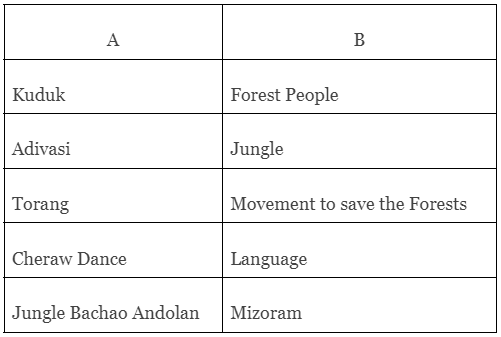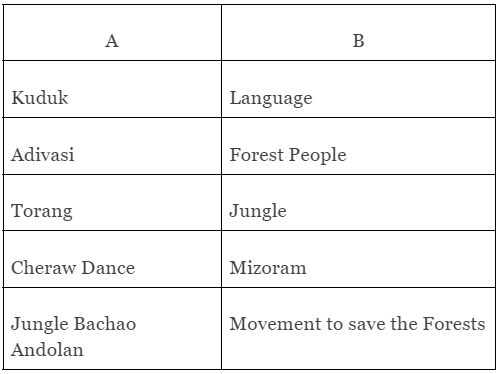Whose Forests? - 2 Class 5 Worksheet EVS Chapter 20
Q1: Match this column:

Ans:
Q2: State whether these statements are true or false
(i) Children were going to shopping mall with Suryamani didi.
Ans: False
(ii) Children enjoy special class in forest.
Ans: True
(iii) Suryamani’s family used to sell the leaves and herbs collected from forest.
Ans: True
(iv) Cheraw dance is performed in Punjab.
Ans: False
Q3: Answer these questions
(i) What do you think is a forest?
Ans: A large area covered by trees and undergrowth is called as Forest.
(ii) Other than trees what all is there in a forest?
Ans: A forest is made up of abiotic and biotic components including animals, birds insects etc.
(iii) What is the web of relationship in forest?
Ans: Plants, trees and animals in a forest depend on each other for food, security and habitat. This is called the web of relationship in a forest.
(iv) Suryamani says, “If the forests are not there, we too will not remain.” Why so?
Ans: Forests provide us wood, medicines, fresh air and many other materials. They also cause rain, keep the climate cold and maintain balance in nature. Therefore, if forests are not there, we too will not remain.
(v) Why did Suryamani’s father move to town?
Ans: After the coming of contractor, it was not possible to pick a single leaf from forest. Suryamnai’s father could no longer support the family on the small land. So he moved to the town in search of work.
(vi) The contractor did not allow Suryamani’s people to go into the forest. Why?
Ans: Contractor had achieved the contract to use forest resources. Therefore, he did not allow Suryamani’s people to go into the forest and collect things.
(vii) Who do you think the forest belongs to?
Ans: Forest is our collective bank. We should take from it only as much as we need. We should not use up all our wealth.
(viii) Give four examples where we use our common resources.
Ans: Four examples where we use our common resources are as follows:
- Building big dams on rivers
- Roads
- Drawing water, petrol or digging for minerals from under the ground.
- Commercial fishing from the sea
(ix) What are the things that Suryamani want from the people of her community?
Ans: Suryamani wants following thing from people of her community:
- On festivals, people shou ld sing their own sons. They should not forget their music.
- They should enjoy wearing their traditional clothes.
- Children should learn about herbs, medicines and the art of making things from bamboo.
- Children should learn the language of school but must link it with their own language.
(x) Chamui said they measure land using tin. What is one tin of land?
Ans: The land on which we grow one tin of seeds is called one tin of land.
(xi) What could be done to save forests?
Ans: We should stop cutting trees and should plant more and more trees to make up for the loss already done.
(xii) Explain in your own words why forests are important for people living in forests?
Ans: Forests are the source of livelihood for people living in forests. They get shelter, firewood, food, medicines, leaves and bamboo for making stuffs etc. from forest. Moreover, their sentiments are attached with forests.
|
38 videos|242 docs|41 tests
|
FAQs on Whose Forests? - 2 Class 5 Worksheet EVS Chapter 20
| 1. What are the main causes of deforestation? |  |
| 2. How does deforestation affect climate change? |  |
| 3. What are the impacts of deforestation on biodiversity? |  |
| 4. How can deforestation be prevented? |  |
| 5. What are the economic impacts of deforestation? |  |
































